
| Sights as you approach Mont Saint-Hilaire in the Fall; vibrant red maples, pumpkin fields, road indicator for the town and panel indicating the access to the quarry. |
I would like to present you a world-renowned site, especially for micro-mounters. Mont Saint-Hilaire probably needs no introduction, due to its diversity and new mineral species to science. There are, however, some less well known facts that I would like to cover lightly. First, I would like to situate the hill, followed by a brief history of its emergence as a collecting locale and a brief geological perspective.
The second topic will cover the different mineral environments present at Mont Saint-Hilaire, that are essential in helping with identification of species found at the site. Last, a few words on the diversity of the quarry, some of the latest finds and prospects for the future.
Visible from Montreal, Mont Saint-Hilaire is 40kms East via the Transcanadian highway (# 20) and rises some 350 meters above the valley floor. Approximately 3 kms in diameter, it lies on the East side of the Richelieu river. The town of Mont Saint-Hilaire is between the hill and the river, on the other slopes of the hill, superb farms lie in the very fertile Saint-Lawrence valley.
Though many petrological studies were carried in the 1800's, it was only at the beginning of this century that the first interesting finds were made by O'Neill (1914). Then, nothing until an amateur collector from Montreal, Frank Melanson, submitted some Desourdy quarry specimens to Gilles Perrault of the Polytechnical School of Montreal in 1963. Amongst these finds, serandite was identified, a rare manganese analog of pectolite. This marked the beginning of the "Gold Rush".
Initially the quarries at Mont Saint-Hilaire were small operations managed by Mr Richard Poudrette, and the Désourdy and Uni-Mix companies in the 50's. Uni-Mix became De-Mix in 1966 and Demix later on. The quarries expand proportionnally with the rapid expansion of the metropolitan region. They merge in the 80's into one operational quarry, the Poudrette quarry. It is now managed by the son of the discoverer of the great potential of the East side of the hill. Mostly producing road base material in the beginning, the main market is now material for the manufacturing of asphalt shingles due to the high quality of the hornfels material. |
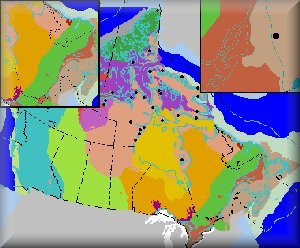 | Canada is incredibly vast and is therefore divided in several distinct geological regions. One of these regions, the Saint-Lawrence Valley takes root in the Great Lakes and carries to the Saint-Lawrence Gulf, 4000kms down river. |
| 135 million years ago, the Saint-Lawrence valley is flat as far as the eyes can see around Montreal island. At that time some magma intrusions form hills that spread in a linear fashion over a distance of 150 kms; these isolated hills are called the Monteregian Hills. The highest of these 10 hills barely reaches 1000 meters (Mont Orford). Most of the hills are leasure centers: Mont-Royal on Montreal island for its superb parc, Mont Saint-Grégoire for its maple syrup, Mont Saint-Bruno for skiing and Mont Saint-Hilaire, for its minerals. |
| Others magma intrusions occur over 15 million years later which form the East side portion of Mont Saint-Hilaire, where the quarries are located. |
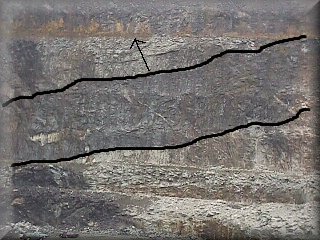 | A total of three intrusions are found at Mont Saint-Hilaire, with the nepheline and sodalite syenites as predominant rocks. These paralkaline syenites are rare at the other Monteregian Hills and are probably the result of the interaction of the magma with a chlorine solution in the upper levels of the terrestrial crust. |
One of the caracteristics of Mont Saint-Hilaire is the diversity of its distinct rock environments. The knowledge and recognition of these environments is essential in identifying the mineral species found at the quarry. Let's have a brief look at these environments, keep in mind that most of them would require several pages individually.
The different environments are the following: hornfels, igneous breccias, marble xenoliths, miarolitic cavities, pegmatites (altered and unaltered), sodalite syenites and sodalite xenoliths. The best publications on the subject are: Mont Saint-Hilaire update in Rocks & Minerals by Wight et Chao (1995) and the special edition on Mont Saint-Hilaire in the Mineralogical Record by Horvath and Gault (1990, Vol 21 no.4). The different sections will link you to the mineralogical suites of each environment (links to ALKALI NUT). |
| A HREF="http://www.ssc.on.ca/mandm/hornfels.html">Hornfels - The hornfels forms a crown around Mont Saint-Hilaire of 10 to several hundred meters in width. Two types of hornfels are present, on formed some distance from the magma that contains more carbonates, and the second formed near the magma containing mostly silicates. The photo on the right points out the dark hornfels, at its base, the bulk of the actual quarry operations. | 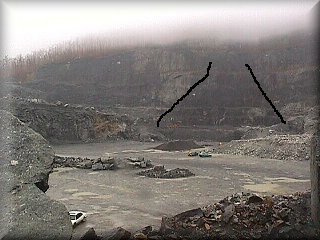 |
 | The first type is dark in colour due to inclusions and usually contains seams and breccias. The second type varies in colour from tan to greenish and rarely contains seams. The photo on left is a good example of greenish hornfels without any crystallized seams. |
Igneous breccias - Igneous breccias consist of rock fragments other that hornfels up to one meter in diameter. The cavities found are usually elongated and up to 15cm in length. They contain a diverse suite of superb crystals. The specimens in this environment are generally smaller having less area to develop.
Miarolitic cavities - Formed by gaz bubbles on the sides and top of the magma intrusion, they vary from 1 to 30 cms in nepheline syenite. These cavities are usually covered with a thin coat of biotie and analcime on which the other species precipitate. This environment produces a suite rich in carbonates and rare-earths.
Pegmatites, altered - These pegmatites present different levels of alteration by fluid derivatives and are generally darker thatn unaltered pegmatites. Species found in this environment are often coated with brown substance.
Pegmatites, unaltered - Found everywhere in the quarry where intrusive rocks are found. They are usually short (a few meters) and unequal in width over their length. Last to crystallize in paragenesis and usually rich in silicates and rare-earths.
|
Sodalite syenite - Probably the least productive environment, rarely presenting cavities. However, in these rare cavities (5cm or less), silicates are abundant, and carbonates and sulfides are found in small quantities. This material is fluorescent due to the presence of sodalite.
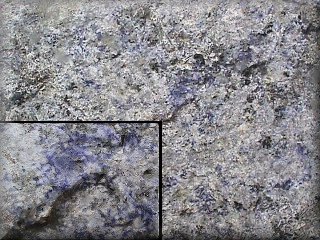 |
| Marble xenoliths - These xenolith are easy to spot due to their light colour, varying from white to pale green, which contrasts nicely with the dark nepheline syenite. From 1 to 2 meters in width, they contain many cavities reaching up to 15 cms. This soft rock absorbs sledge hammer blows and requires some patience to crack. An example of some xenoliths a few meters across.
| 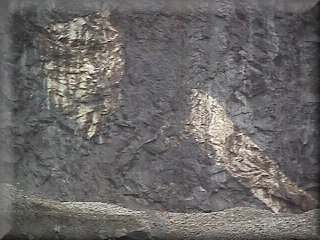 |
Sodalite xenoliths - Sodalite xenoliths have produced the bulk of recent additions at Mont Saint-Hilaire. From 5cm to 1 meter they are usually very productive. It is in one of these 3 square meter xenoliths that over 80 species were found. Easy to identify due to its colour and grain size that create many seams. It is the most sought after environment at the quarry.
Once more, this is only a brief look at the rock environments found at Mont Saint-Hilaire. Upon inspection of your specimens, the determination of the rock environment is still one of the best tools to assist in identifying your species from Mont Saint-Hilaire. |
| Mont Saint-Hilaire is certainly not the most prolific site. According to the list from the Canadian Museum of Nature, 320 species have been identified. There are (at least) 6 species being described and a further 50 unidentified species that will require more scientific analysis. What makes Mont Saint-Hilaire so special is the size of the quarry, a mere 30 hectares (0.5 square kms), when compared to the thousands of square kilometers of the Kola Peninsula. 81 species were recently unearthed in a pegmatite of 3 square meters. (Modris Baum photo of thomasclarkite-(Y), formerly UK-93) |  |
Year after year, the site produces new rare-earth species and others. The Canadian Museum of Nature has published an interesting article on new species discovered during a re-examination of eudialyte from the quarry. Manganokhomyakovite is mentioned as one of the 5 new species to be described (4 from MSH).
Dr Andy McDonald, of Laurentian University Sudbury, Ontario, has taken over the unknown species files from Dr George Chao of Ottawa. On sabbatical, more analysis on some of these unknowns should clear their status. As a result, we should probably see 10 new species bringing the number of type localities to near 50 and the total number of species approaching 350. As an example, UK-32, the oldest of the Mont Saint-Hilaire unknowns should be described as a new species in the forthcoming months. |
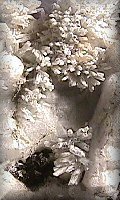 | On another front, Mont Saint-Hilaire just saw one of its type localities, tetranatrolite (left photo), be discredited in a recent publication. At MSH, tetranatrolite is gonnardite. There is also a possibility that paranatrolite is also gonnardite, though no discreditation process is currently underway. |
So, what does Mont Saint-Hilaire have in stock for amateurs and scientists, no one really knows. This year has probably seen the worst collecting in quarry history for collectors. There has been some interesting localized finds, though nothing truly exciting. This is due in part to the current activities of the quarry following the hornfels for the asphalt shingles material. Mineralogically, hornfels is fairly poor, however, if the contact zones are revealed, who knows. That being said, one of the longest standing amateur collectors of Mont Saint-Hilaire, Marcelle Webber (charmarite) with over 30 years of collecting, reports that at her last outing in September she has identified over 50 species. Bad year for collecting at ..., everything is relative.
As far as the operations of the quarry is concerned, the actual owner of the quarry, son of Richard Poudrette, maintains that there should be another 10 years of operations ahead. Only time will tell. Maybe some environmentalist group will try to close the quarry, as it is an eye sore when viewed from the East.
With much material still available, the mineralogical community remains confident that many more discoveries will be made by scientists and micro-mounters and that many more surprises are still left to be unearthed at Mont Saint-Hilaire. Happy Hunting. (Faujasite-Na found at Mont Saint-Hilaire in 1998, Modris Baum specimen and photo) |
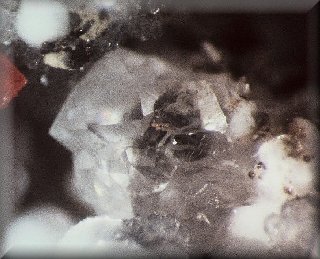
Classics from Mont Saint Hilaire :
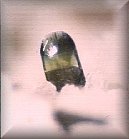
Aegyrine
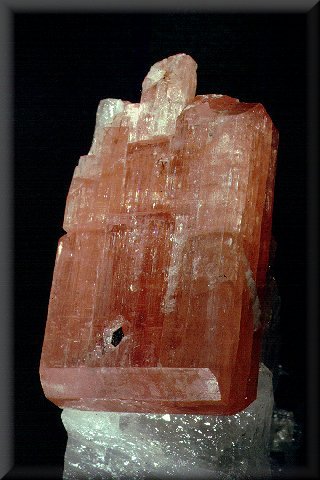
Serandite, Royal Ontario Museum spécimen, photo par Violet Anderson
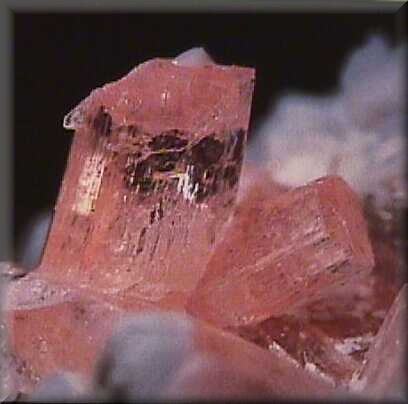
Serandite #2, Photo & spécimen par Quintin Wight
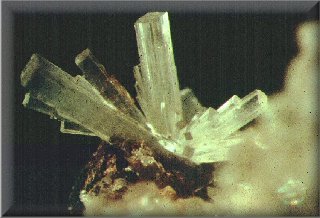
Monteregianite, Modris Baum, photo & spécimen
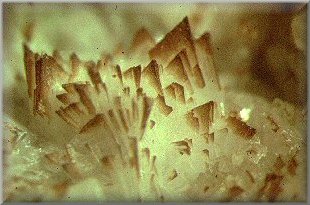
Eudidymite, photo & spécimen Modris Baum
|








